NEAR at Mathilde
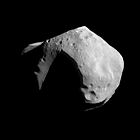 NASA’s NEAR (Near Earth Asteroid Rendezvous) unmanned spacecraft closes to within 750 miles of its first target, asteroid 253 Mathilde. Taking over 500 pictures of the asteroid and determining its mass and dimensions (roughly 31 miles in diameter). At the time of this flyby, Mathilde is the largest asteroid to be explored by a spacecraft. Discovered in 1885, Mathilde takes four years to orbit the sun within the main asteroid belt between Mars and Jupiter. NEAR Shoemaker moves on to its next destination, asteroid 433 Eros, which it is expected to reach in 1998.
NASA’s NEAR (Near Earth Asteroid Rendezvous) unmanned spacecraft closes to within 750 miles of its first target, asteroid 253 Mathilde. Taking over 500 pictures of the asteroid and determining its mass and dimensions (roughly 31 miles in diameter). At the time of this flyby, Mathilde is the largest asteroid to be explored by a spacecraft. Discovered in 1885, Mathilde takes four years to orbit the sun within the main asteroid belt between Mars and Jupiter. NEAR Shoemaker moves on to its next destination, asteroid 433 Eros, which it is expected to reach in 1998.
NEAR launched
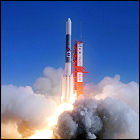 The NEAR (Near Earth Asteroid Rendezvous) unmanned spacecraft, built and flown for NASA by John Hopkins University’s Applied Physics Lab, lifts off from Cape Canaveral on a mission to orbit and study asteroid 433 Eros, a target it won’t reach until 1998 at the earliest; it will fly by another asteroid in 1997. Other trajectories under consideration during mission planning included a combination of several asteroids and comets, before the limitations of NEAR’s chemical propulsion system forced those plans to be scaled back. (A more ambitious multi-asteroid mission, Dawn, will be launched in the 21st century.) NEAR will become the first human-made spacecraft to land on an asteroid.
The NEAR (Near Earth Asteroid Rendezvous) unmanned spacecraft, built and flown for NASA by John Hopkins University’s Applied Physics Lab, lifts off from Cape Canaveral on a mission to orbit and study asteroid 433 Eros, a target it won’t reach until 1998 at the earliest; it will fly by another asteroid in 1997. Other trajectories under consideration during mission planning included a combination of several asteroids and comets, before the limitations of NEAR’s chemical propulsion system forced those plans to be scaled back. (A more ambitious multi-asteroid mission, Dawn, will be launched in the 21st century.) NEAR will become the first human-made spacecraft to land on an asteroid.
Galileo eyes Ida
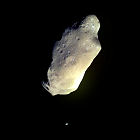 Bound for Jupiter, the NASA/JPL unmanned space probe Galileo swings past the asteroid Ida, discovering – for the first time – an asteroid with its own satellite, a tiny body orbiting Ida. The satellite is later named Dactyl. This is only the second asteroid to be visited by a spacecraft from Earth, and Ida also marks Galileo’s last visit to a body in the solar system before a two-year cruise toward Jupiter.
Bound for Jupiter, the NASA/JPL unmanned space probe Galileo swings past the asteroid Ida, discovering – for the first time – an asteroid with its own satellite, a tiny body orbiting Ida. The satellite is later named Dactyl. This is only the second asteroid to be visited by a spacecraft from Earth, and Ida also marks Galileo’s last visit to a body in the solar system before a two-year cruise toward Jupiter.
Galileo gawks at Gaspra
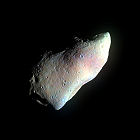 NASA/JPL’s Galileo space probe, looping repeatedly through the inner solar system to gain a speed boost from a series of gravity assists from Earth and Venus, passes the asteroid 951 Gaspra, the first human-made spacecraft to visit such a body. Where humanity’s previous knowledge of asteroids was limited at best, Galileo’s findings are startling, with photos showing a small rocky body pummeled by ancient impacts, almost to the point of shattering it. Also discovered is a magnetic field generated by the core of the asteroid itself, something planetary scientists did not expect to find at all. Galileo will loop back toward Earth, picking up a critical speed boost to Jupiter from one last flyby of its home planet.
NASA/JPL’s Galileo space probe, looping repeatedly through the inner solar system to gain a speed boost from a series of gravity assists from Earth and Venus, passes the asteroid 951 Gaspra, the first human-made spacecraft to visit such a body. Where humanity’s previous knowledge of asteroids was limited at best, Galileo’s findings are startling, with photos showing a small rocky body pummeled by ancient impacts, almost to the point of shattering it. Also discovered is a magnetic field generated by the core of the asteroid itself, something planetary scientists did not expect to find at all. Galileo will loop back toward Earth, picking up a critical speed boost to Jupiter from one last flyby of its home planet.
The Chicxulub Crater Theory
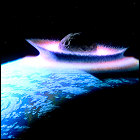 In the journal Science, in an article titled “Extraterrestrial Cause for the Cretaceous-Tertiary Extinction”, Nobel-Prize-winning physicist Luis Alvarez and his son, geologist Walter Alvarez, propose their theory that the 110-mile-wide Chicxulub Crater discovered in the past few decades on the northern tip of the Yucatan Peninsula in Mexico is evidence of a large asteroid collision with Earth, resulting in the widespread death of the dinosaurs 65 million years before the modern day. A contentious peer review of the published theory follows, with many opposing theories proposed, though the Chicxulub hypothesis is eventually accepted as the “smoking gun” that killed the dinosaurs (the theory of an asteroid collision with Earth causing the extinction had been in circulation since the 1950s; the Alvarez theory is the first to point to a specific geological feature as evidence).
In the journal Science, in an article titled “Extraterrestrial Cause for the Cretaceous-Tertiary Extinction”, Nobel-Prize-winning physicist Luis Alvarez and his son, geologist Walter Alvarez, propose their theory that the 110-mile-wide Chicxulub Crater discovered in the past few decades on the northern tip of the Yucatan Peninsula in Mexico is evidence of a large asteroid collision with Earth, resulting in the widespread death of the dinosaurs 65 million years before the modern day. A contentious peer review of the published theory follows, with many opposing theories proposed, though the Chicxulub hypothesis is eventually accepted as the “smoking gun” that killed the dinosaurs (the theory of an asteroid collision with Earth causing the extinction had been in circulation since the 1950s; the Alvarez theory is the first to point to a specific geological feature as evidence).
Voyagers survive the asteroid belt
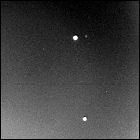 Voyager 1 emerges unharmed from what is considered the outer limit of the asteroid belt between Mars and Jupiter, having entered this 223,000,000-mile-wide zone of space in December 1977. Voyager 2 is expected to emerge similarly unscathed in late October 1978. NASA’s Pioneer 10 and 11 spacecraft had already demonstrated, in the early 1970s, that passage through the asteroid belt without mission-jeopardizing damage is possible. Both spacecraft are already imaging Jupiter from a distance of less than 180,000,000 miles, now meeting or exceeding the resolution of the best photos of Jupiter taken from Earth-based telescopes.
Voyager 1 emerges unharmed from what is considered the outer limit of the asteroid belt between Mars and Jupiter, having entered this 223,000,000-mile-wide zone of space in December 1977. Voyager 2 is expected to emerge similarly unscathed in late October 1978. NASA’s Pioneer 10 and 11 spacecraft had already demonstrated, in the early 1970s, that passage through the asteroid belt without mission-jeopardizing damage is possible. Both spacecraft are already imaging Jupiter from a distance of less than 180,000,000 miles, now meeting or exceeding the resolution of the best photos of Jupiter taken from Earth-based telescopes.
A near miss: the Great 1972 Fireball
 In the broad daylight of mid-afternoon, an asteroid measuring somewhere between 10 and 50 feet in diameter plows through Earth’s atmosphere over North America, creating a long-tailed fireball across the sky. Undetected before its close pass – only 35 miles from Earth’s surface – asteroid US19720810 skips off of the atmosphere and back into space, having lost half of its mass to the frictional heating of plummeting through the atmosphere. The spectacle lasts only a couple of minutes, and US19720810 will make another pass by the Earth in 1997 (though not at such a close distance).
In the broad daylight of mid-afternoon, an asteroid measuring somewhere between 10 and 50 feet in diameter plows through Earth’s atmosphere over North America, creating a long-tailed fireball across the sky. Undetected before its close pass – only 35 miles from Earth’s surface – asteroid US19720810 skips off of the atmosphere and back into space, having lost half of its mass to the frictional heating of plummeting through the atmosphere. The spectacle lasts only a couple of minutes, and US19720810 will make another pass by the Earth in 1997 (though not at such a close distance).
Pioneer 10 plunges into the asteroid belt
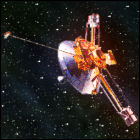 En route to becoming the first human-made spacecraft to visit Jupiter, NASA’s Pioneer 10 also becomes the first human-made spacecraft to enter the asteroid belt between the orbits of Mars and Jupiter. Whether or not the spacecraft will survive this crossing is indeed one of the mission’s major experiments, and is a topic of active debate between scientists with differing views of how densely populated the asteroid belt may be. The spacecraft will survive the crossing without incident.
En route to becoming the first human-made spacecraft to visit Jupiter, NASA’s Pioneer 10 also becomes the first human-made spacecraft to enter the asteroid belt between the orbits of Mars and Jupiter. Whether or not the spacecraft will survive this crossing is indeed one of the mission’s major experiments, and is a topic of active debate between scientists with differing views of how densely populated the asteroid belt may be. The spacecraft will survive the crossing without incident.